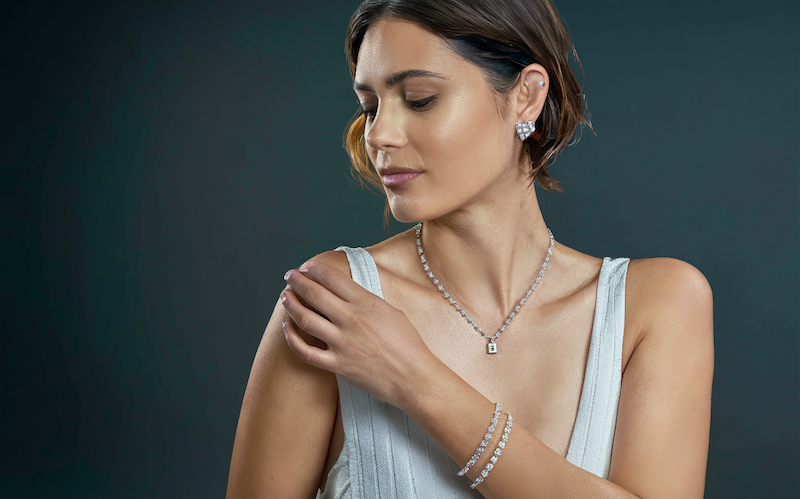In the quest for beautiful, durable, and affordable jewelry, cubic zirconia (CZ) stands out as a popular choice among consumers. Known for its striking resemblance to diamonds, cubic zirconia offers the sparkle and brilliance that many desire without the hefty price tag. However, for those with sensitive skin or allergies to certain metals, the question of whether cubic zirconia is hypoallergenic is of paramount importance. This article delves into the hypoallergenic properties of cubic zirconia, exploring the materials used in its setting and providing guidance for those seeking allergy-friendly jewelry options.
Understanding Hypoallergenic Jewelry

The term “hypoallergenic” refers to materials that are less likely to cause an allergic reaction. In the context of jewelry, this typically means that the item is free of common allergens like nickel, lead, and cadmium, which can provoke skin irritation or allergic dermatitis in sensitive individuals.
Skin allergies, affecting millions worldwide, occur when the immune system overreacts to a specific substance, triggering an inflammatory response. This response manifests as various symptoms, including:
- Itching: This is the most common symptom, ranging from mild to severe.
- Redness: The affected area might become red, inflamed, and swollen.
- Rash: Skin rashes, including hives and eczema, can appear on the area of contact or spread to other parts of the body.
- Blistering: In severe cases, blistering may occur on the affected area of the skin.
The severity of these symptoms can vary significantly from person to person, depending on the individual’s sensitivity and the specific allergen. Consulting a dermatologist for diagnosis and treatment is crucial if you experience any persistent or concerning skin reactions.
The Composition of Cubic Zirconia

Cubic zirconia itself is a synthetic gemstone created in laboratories. Its chemical composition is zirconium dioxide (ZrO2), a naturally occurring mineral found in the earth’s crust. This material is considered inherently hypoallergenic, meaning it is unlikely to trigger allergic reactions in most individuals.
Cubic zirconia itself is a synthetic gemstone made from zirconium dioxide. This compound is known for its durability, clarity, and absence of inherent allergenic materials. As such, the cubic zirconia stone is generally considered hypoallergenic. However, the hypoallergenic properties of a cubic zirconia piece of jewelry depend not only on the stone but also on the materials used in the setting.
Metal Alloys in Jewelry Settings
Many cubic zirconia jewelry pieces are set in metal alloys that may contain nickel or other allergenic substances. The presence of these metals can potentially cause allergic reactions in individuals with sensitive skin. Common metal alloys used in jewelry settings include:
- Sterling Silver: Often used for its beauty and affordability, sterling silver can sometimes contain nickel, though high-quality sterling silver is generally considered hypoallergenic.
- Stainless Steel: Known for its durability and hypoallergenic properties, stainless steel is a popular choice for sensitive skin. However, it’s essential to ensure that the stainless steel is nickel-free.
- Gold and Platinum: Higher karat gold and platinum are typically hypoallergenic, but the cost may be prohibitive for some buyers.
- Other Additives: Apart from metal settings, some jewelry might contain additional materials like adhesives or coatings that could potentially trigger allergies.
Choosing Hypoallergenic Cubic Zirconia Jewelry
For those with allergies or sensitive skin, selecting hypoallergenic cubic zirconia jewelry involves paying close attention to the composition of both the stone and its setting. Here are some tips for making an allergy-friendly choice:
- Look for Nickel-Free Labels: Jewelry explicitly labeled as “nickel-free” is a safer choice for those with nickel allergies.
- Consider the Metal Alloy: Opt for jewelry made with metals known for their hypoallergenic properties, such as platinum, high-karat gold, or nickel-free stainless steel.
- Consult with a Jeweler: When in doubt, consult with a professional jeweler who can provide detailed information about the materials used in cubic zirconia jewelry.
While cubic zirconia is generally considered hypoallergenic, it’s crucial to remember that individual sensitivities can vary. Some individuals might have allergies to specific metals, chemicals, or other components present in the jewelry, even if the cubic zirconia itself is not a trigger.
Therefore, it’s always recommended to test the jewelry on a small area of your skin before wearing it for an extended period. Apply the jewelry to a clean, dry area of your inner arm and monitor for any signs of irritation for 24-48 hours. If you experience any redness, itching, or other symptoms, discontinue use and consult a dermatologist to determine the cause of the reaction.
Conclusion
While cubic zirconia is hypoallergenic, the overall allergenic potential of a piece of cubic zirconia jewelry depends on the metals used in its setting. By choosing jewelry made with hypoallergenic metals and being mindful of the composition of alloyed materials, individuals with sensitive skin can enjoy the beauty of cubic zirconia without the worry of allergic reactions.
FAQs
Is cubic zirconia safe for all skin types?
Cubic zirconia is safe for most skin types, as the stone itself is hypoallergenic. However, the metal used in the jewelry’s setting can cause reactions in individuals with specific metal allergies.
Can cubic zirconia jewelry cause skin irritation?
The cubic zirconia stone will not cause skin irritation, but the metal alloys used in the setting, if they contain allergens like nickel, might provoke reactions in sensitive individuals.
How can I tell if cubic zirconia jewelry is hypoallergenic?
Look for jewelry labeled as “nickel-free” or made with known hypoallergenic metals such as platinum or high-karat gold. Consulting with the jeweler about the materials can also provide clarity.
References
- American Academy of Dermatology: https://www.aad.org/public/diseases/eczema/types/contact-dermatitis
- National Center for Biotechnology Information: https://www.ncbi.nlm.nih.gov/pmc/articles/PMC10728541/
- International Gemological Institute: https://www.igi.org/



